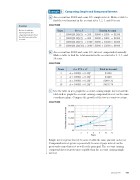Page 806 - Algebra 1
P. 806
Comparing Simple and Compound Interest
a. An account has $1000 and earns 20% simple interest. Make a table to find the total amount in the account after 1, 2, 5, and 10 years.
SOLUTION
b. An account has $1000 and earns 20% interest compounded annually. Make a table to find the total amount in the account after 1, 2, 5, and 10 years.
SOLUTION
c. Use the table in a to graph the account earning simple interest and the table in b to graph the account earning compound interest on the same coordinate plane. Compare the growth of the two accounts over time.
Example
3
Caution
Be sure to add the interest paid to the original principal to find the total amount in the account.
Years
Prt = I
Total in Account
1
(1000)(0.20)(1) = 200
$1000 + $200 = $1200
2
(1000)(0.20)(2) = 400
$1000 + $400 = $1400
5
(1000)(0.20)(5) = 1000
$1000 + $1000 = $2000
10
(1000)(0.20)(10) = 2000
$1000 + $2000 = $3000
Years
A = P(1 + r)t
Total in Account
1
A = 1000(1 + 0.20)1
$1200
2
A = 1000(1 + 0.20)2
$1440
5
A = 1000(1 + 0.20)5
$2488.32
10
A = 1000(1 + 0.20)10
$6191.74
SOLUTION
$8,000 $6,000 $4,000 $2,000
$0
Compound Interest
Simple Interest
2 4 6 8 10 12
Years
Simple interest grows linearly because it adds the same amount each year. Compound interest grows exponentially because it pays interest on the previously-earned interest as well as the principal. The account earning compound interest grows more rapidly than the account earning simple interest.
Lesson 116 791
Total Amount in Account


